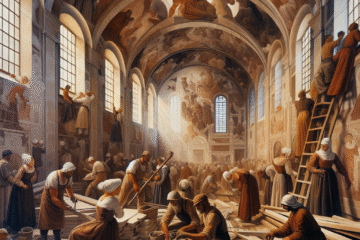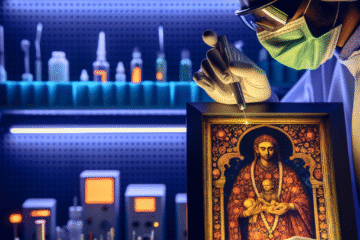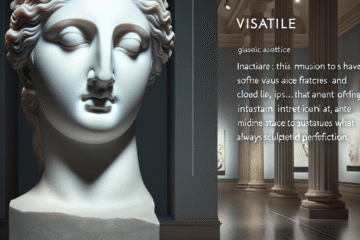I. Introduction
The transition from Classicism to Romanticism is one of the most significant transformations in the history of art. These two movements represent opposing viewpoints and reflect the social and cultural changes of their respective time periods. Classicism emerged in the 18th century during the Enlightenment era, a time of reason, logic, and rationality. On the other hand, Romanticism arose in the 19th century as a reaction against the industrialization, urbanization, and rationalism that dominated society.
During the 18th century, Classicism was the dominant artistic movement. Artists sought to create works of art that were based on classical Greek and Roman ideals, emphasizing order, balance, symmetry, and rationality. Classical artworks were characterized by their simplicity, clarity, and precision. Classicism was influenced by the Enlightenment, a movement that championed reason and the scientific method as a means of understanding the world.
In the 19th century, however, Romanticism emerged as a reaction against the rationalism and order of Classicism. Romanticism was characterized by its focus on emotion, individualism, and nature. Romantic artists sought to create works of art that were expressive, imaginative, and spontaneous. They were interested in exploring the inner workings of the human mind and the mysteries of the natural world.
The transition from Classicism to Romanticism marked a significant shift in the way artists approached their work. Classicism was characterized by an emphasis on order, structure, and rationality, while Romanticism emphasized emotion, individualism, and intuition. The transition from Classicism to Romanticism represents a transformation of art from the rational to the emotional.
In this article, we will explore the transition from Classicism to Romanticism and the impact that it had on the world of art. We will discuss the key characteristics of Classicism and Romanticism, the historical context in which these movements emerged, and the ways in which they influenced art movements that followed. We will also examine some examples of artworks that illustrate the transition from Classicism to Romanticism. Overall, this article aims to demonstrate the significance of the transformation of art from Classicism to Romanticism and its lasting impact on art and culture.
II. Classicism: The Art of Reason
Classicism is an artistic movement that emerged in the 18th century and was based on the classical Greek and Roman ideals of beauty and perfection. Classicism was characterized by its emphasis on order, balance, and symmetry, as well as its use of simple, clear lines and forms. The movement aimed to create works of art that were rational, logical, and based on reason, rather than emotion or imagination.
One of the most famous classical artworks is the sculpture of Venus de Milo, which was created during the Hellenistic period in ancient Greece. This statue represents the classical ideal of beauty, with its harmonious proportions, balanced composition, and idealized form. Other famous examples of classical artworks include the Parthenon in Athens, which exemplifies classical architecture, and the works of the Italian painter Raphael, whose paintings were inspired by classical mythology and literature.
The key characteristics of Classicism include its emphasis on order, balance, and symmetry. Classicism also favored simplicity, clarity, and precision over complexity and ambiguity. Classicism was rooted in the belief that art should be based on reason and logic, rather than emotion or imagination. In terms of style, Classicism was marked by its use of simple, clear lines and forms, and its avoidance of excessive decoration or ornamentation.
Classicism reflected the values and ideals of the Enlightenment, which was a movement that emerged in Europe during the 18th century. The Enlightenment was characterized by its emphasis on reason, science, and progress. It was a time when intellectuals sought to use reason and the scientific method to understand the world and improve human society. Classicism was seen as a reflection of the rational, ordered, and harmonious universe that Enlightenment thinkers believed existed.
The rise of Classicism in the 18th century was influenced by several factors. One of the most important was the discovery of ancient Greek and Roman art and literature. This led to a renewed interest in classical ideals and a desire to emulate the art of ancient Greece and Rome. Classicism was also influenced by the Baroque style, which preceded it, but Classicism sought to simplify and refine the Baroque style, while retaining its sense of drama and theatricality.
Overall, Classicism was an important movement in the history of art, and its influence can still be seen in art and architecture today. Its emphasis on order, balance, and symmetry reflects the values and ideals of the Enlightenment, and its influence can be seen in the art and architecture of the 18th and 19th centuries. However, the rise of Romanticism marked a significant departure from Classicism and represented a new era in the history of art.
III. Romanticism: The Art of Emotion
Romanticism is an artistic movement that emerged in the late 18th and early 19th centuries in Europe. It was characterized by its focus on emotion, individualism, and nature, and it represented a departure from the rationalism and order of Classicism. Romanticism was a reaction against the industrialization, urbanization, and rationalism that dominated society in the 19th century.
One of the most famous romantic artworks is the painting “The Wanderer Above the Sea of Fog” by Caspar David Friedrich. This painting portrays a solitary figure standing on a mountaintop, gazing out over a vast, misty landscape. The painting reflects the romantic ideals of individualism, emotion, and the sublime. Other famous examples of romantic artworks include the poetry of William Wordsworth and Samuel Taylor Coleridge, the music of Ludwig van Beethoven, and the novels of Jane Austen and Mary Shelley.
The key characteristics of Romanticism include its focus on emotion, individualism, and nature. Romantic artists sought to express their feelings and emotions through their art, and they emphasized the individual over the collective. They were interested in exploring the inner workings of the human mind and the mysteries of the natural world. Nature was seen as a source of inspiration and spiritual renewal, and romantic artists often depicted landscapes, seascapes, and other natural scenes in their work.
Romanticism was a reaction against the rationalism and order of Classicism. Romantic artists rejected the idea that art should be based on reason and logic, and instead emphasized the importance of emotion and imagination. They were critical of the industrialization and urbanization that were transforming society in the 19th century, and they sought to create works of art that were more personal, expressive, and spiritual.
The rise of Romanticism in the 19th century was influenced by several factors. One of the most important was the social and political upheavals that were occurring in Europe at the time, including the French Revolution and the Napoleonic Wars. These events sparked a renewed interest in individualism, freedom, and self-expression. Romanticism was also influenced by the growing interest in nature and the environment, which was a reaction against the urbanization and industrialization of the 19th century.
Overall, Romanticism was an important movement in the history of art, and its influence can still be seen in art and culture today. Its emphasis on emotion, individualism, and nature represented a departure from the rationalism and order of Classicism, and it paved the way for later movements in art, such as Realism and Impressionism.
IV. The Transformation of Art
The transition from Classicism to Romanticism represents a significant transformation of art from the rational to the emotional. Classicism and Romanticism were two opposing movements that represented different views of the world and human nature. In this section, we will compare and contrast these two movements in terms of their key characteristics, themes, and styles, and we will explore how Romanticism influenced art movements that followed it.
Classicism and Romanticism differed in terms of their key characteristics, themes, and styles. Classicism emphasized order, balance, and symmetry, while Romanticism emphasized emotion, individualism, and nature. Classicism was characterized by its use of simple, clear lines and forms, while Romanticism was marked by its expressiveness, imagination, and spontaneity. Classicism was rooted in the rational, logical universe of the Enlightenment, while Romanticism was a reaction against the industrialization and urbanization of the 19th century.
Romanticism represented a transformation of art from the rational to the emotional. Romantic artists sought to express their feelings and emotions through their art, and they emphasized the importance of individualism and the inner workings of the human mind. They were interested in exploring the mysteries of the natural world and the supernatural, and they sought to create works of art that were more personal, expressive, and spiritual than those of Classicism. Romanticism represented a departure from the rationalism and order of Classicism, and it paved the way for later movements in art that were more expressive and emotional.
Romanticism influenced art movements that followed it, such as Realism and Impressionism. Realism was a movement that emerged in the mid-19th century and was characterized by its focus on the everyday lives of ordinary people. Realist artists sought to capture the world as it really was, rather than idealizing or romanticizing it. Impressionism, which emerged in the late 19th century, was characterized by its focus on the momentary and transient, and its use of light and color to capture the sensory experience of the world.
Some examples of artworks that demonstrate the transition from Classicism to Romanticism include the paintings of Jacques-Louis David and the works of Eugene Delacroix. David was a neoclassical painter who was influenced by the ideals of the Enlightenment. His paintings, such as “The Death of Marat,” were characterized by their order, clarity, and simplicity. Delacroix, on the other hand, was a romantic painter who was influenced by the emotions and individualism of Romanticism. His paintings, such as “Liberty Leading the People,” were characterized by their expressiveness, imagination, and spontaneity.
Overall, the transformation of art from Classicism to Romanticism represented a significant shift in the way artists approached their work. Romanticism represented a departure from the rationalism and order of Classicism, and it paved the way for later movements in art that were more expressive and emotional. The influence of Romanticism can still be seen in art and culture today, and its impact on the history of art is significant.
V. Conclusion
In this article, we have explored the transformation of art from Classicism to Romanticism. We have discussed the key characteristics, themes, and styles of these two movements, and we have explored how Romanticism represented a departure from the rationalism and order of Classicism. We have also discussed how Romanticism influenced art movements that followed it, such as Realism and Impressionism.
Classicism was an artistic movement that emerged in the 18th century and was based on the classical Greek and Roman ideals of beauty and perfection. Classicism was characterized by its emphasis on order, balance, and symmetry, as well as its use of simple, clear lines and forms. In contrast, Romanticism was an artistic movement that emerged in the late 18th and early 19th centuries and was characterized by its focus on emotion, individualism, and nature.
Romanticism represented a significant transformation of art from the rational to the emotional. Romantic artists sought to express their feelings and emotions through their art, and they emphasized the importance of individualism and the inner workings of the human mind. They were interested in exploring the mysteries of the natural world and the supernatural, and they sought to create works of art that were more personal, expressive, and spiritual than those of Classicism.
The impact of Romanticism on art and culture has been significant. Romanticism paved the way for later movements in art that were more expressive and emotional, such as Realism and Impressionism. The influence of Romanticism can still be seen in art and culture today, from literature and music to film and television. The transformation of art from Classicism to Romanticism represented a significant shift in the way artists approached their work, and it continues to shape the way we think about art and creativity today.
In conclusion, the transformation of art from Classicism to Romanticism represents an important moment in the history of art. These two movements represent opposing viewpoints and reflect the social and cultural changes of their respective time periods. The transition from Classicism to Romanticism represents a transformation of art from the rational to the emotional, and its influence on art and culture has been significant and enduring.


